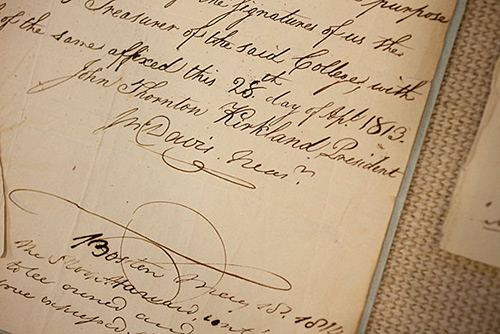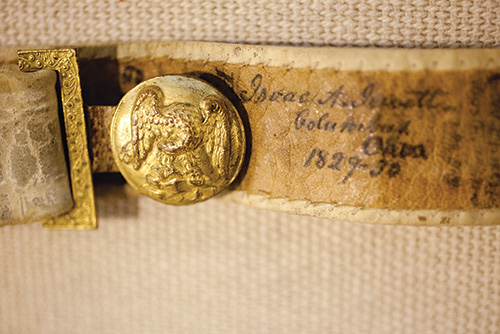Harvard’s lucky ’13s
In three prior centuries, graduates of that year left a rapidly changing Harvard to enter a seemingly stable world
By some accounts, 13 is unlucky. But it certainly isn’t for graduates of the Class of 2013: They’re getting degrees from Harvard.
It wasn’t unlucky in 1913 either. That year, after all, was the last in a golden age before two world wars.
Nor was 1813 an unlucky year. The unfolding War of 1812 left Harvard College nearly unscathed — though deliveries of firewood from Maine and books from England were interrupted.
In 1713, Harvard was lucky again. There was money to spare, for once, and increasingly liberal administrators began to cast off sober Puritan rule.
Each of these Harvard years embodied moments of dramatic transition. Here’s a glimpse back:
1713
Seeing Harvard Yard in 1713 would occasion shock. In a former cow yard only 110 feet wide, there were three main buildings, a brewery, privies, a hay field, and a barn. The Yard was nearly treeless, with a single elm next to old Harvard Hall.
But in good weather, students found relief from the sun in the former Spencer Orchard, a grove of apple trees where Holden Chapel stands today. (The orchard, which was set aside in 1712 as a “play space” for students, was the first gift to Harvard from alumni.) On either side of the Yard were pens for livestock. Just to the west was the arrow-shaped tip of Cambridge Common. Wolves still roamed there at night.
Still roaming at Harvard College were the ghosts of religious restraint. Harvard’s last Puritan president, Increase Mather (1692-1701), sponsored the Yard’s only book burning, defended the Salem witch trials, and sermonized against showy clothing and alcohol use. He imposed a fine of 20 shillings for serving plum cake, a dish he regarded as an intoxicant, at Commencement.
Mather’s successor was former judge John Leverett, Harvard’s first secular president. At Leverett’s nonpuritanical inauguration, celebrants ate 146 pounds of meat, put away 19 pies, drank 16 gallons of wine, and used 2 pounds of pipe tobacco.
Leverett led Harvard’s transition until his death in 1724. It was a liberalizing era, described by one historian as a time when “the stamp of doubt and inquiry was forever burned into the seal of the books of Veritas.” Leverett broke with a Harvard Commencement tradition of calling graduates “Sons of the Prophets,” preferring instead the appellation “Sons of Harvard.” By 1708, his inaugural year, more than half of Harvard’s 531 graduates since 1642 had become ministers. In the period 1722-1801 — an era propelled by Leverett — only 27 percent of graduates did so.
To official keepers of Harvard history, the year 1713 seemed uneventful. It was mentioned a single time in just one of the two pre-eminent 19th-century College histories. Harvard’s Overseers failed to record a single 1713 entry. Corporation records have little to say, beyond setting the price of College cider that year. But the bigger picture, with Leverett as the lens, is dramatic. Harvard staved off ideological attacks from Puritans, increased the endowment, boosted enrollments, and named its first endowed chair.

1813
For Harvard, 1813 was another moment of expansion and transition embodied by another beloved and breakthrough president, John Thornton Kirkland. His time in office (1810-1828) reprised the liberalizing wave of the Leverett era. (One historian called the Kirkland presidency “the time of the giants,” in part because of the students at Harvard then. Ralph Waldo Emerson, for instance, was at Harvard during that time.) It was also a time of literal expansion. Holworthy Hall, the first College residence to include lounging rooms, had just opened the previous fall. The cornerstone for University Hall was laid in 1813, complete with the inscribed silver plate that still lies beneath it.
Kirkland had an expansive sense of the student body too. He arranged jobs for impoverished students, improved scholarship opportunities, and encouraged admissions applications from beyond New England. (Harvard saw its first influx of Southerners.) There were also changes to the landscape. The Yard was cleared of its privies, brew house, woodlot, and pigpen, where the noise of periodic slaughters had interrupted recitations. Kirkland planted Harvard’s storied elm trees (most died around 1910) and laid out pathways that are still there.

1913
The Class of 1913 was launched into the world during another period of Harvard expansion, both literal and ideological. Classes were getting bigger. The number of senior pictures in the class album that year was 577, more than any before. The “President’s New House” — now Loeb House — had just opened. Drawings were published of prospective dormitories along the Charles River, the planned Germanic Museum (now the Busch-Reisinger Museum), and Widener Library. Gore Hall, Harvard’s library since 1838, was demolished early in 1913. “Our joy was intense,” the class album enthused, because Gore Hall was said to possess “the hardest seats on earth.”
As for liberalizing influences: The class started as freshmen in 1909, the first year for reformist President A. Lawrence Lowell. During his groundbreaking term, which ended in 1933, he established a system of concentrations, opened a Department of University Extension (where half of the first students were women), revolutionized the housing system to blend social classes, and revised entrance requirements to give public school students an equal chance at admission. In 1913, they became the majority of the student body for the first time.
There were other signs of reform, including the class’s international flair. Graduates came from Bulgaria, Russia, Turkey, “Turkey-in-Asia,” Switzerland, India, China, and Siam (now Thailand). One Siam graduate likely holds the record for the shortest full name on a Harvard diploma: Aab. In what may be another record, Aram Hovhannes Khachadoorian, from Aintab, Turkey-in-Asia, was 14 years and 17 days old when he graduated. (The oldest College graduate in the class was three weeks shy of 33.) There were also two black graduates in the class. One Siam graduate likely holds the record for the shortest full name on a Harvard diploma: “Aab.” In what may be another record, Aram Hovhannes Khachadoorian, from Aintab, Turkey-in-Asia, was 14 years and 17 days old when he graduated. (The oldest College graduate in the class was three weeks shy of 33.) There were also a black graduate in the class, Theodore Cable of Topeka, who played the violin and was a champion hammer thrower.
Much seems foreign today about the Harvard of 1913 — all those undergraduate clubs, for instance. Hasty Pudding, Fly, Owl, and Porcellian are still with us. But long gone are a few others, including Pi Eta, Triangle, and Stylus. Still, much also seems timeless about 1913 too, including the recurrent spooky contemporaneity of faces and certain recurrent sentiments. One senior wrote in the class album, for example, “The outlook for our future is most bright.”
If happiness counts, the future was most bright for Talbot Coggeshall Chase (1892-1977). “He majored in having a good time,” said his grandson, Michael Sherman ’72. “He was the most social human being I ever knew.” Chase joined a Boston bond firm, served with the Army in wartime France, and had a career in business. He was a regular at reunions, including the landmark gathering of 1973. “We had fun sharing my first reunion,” said Sherman, “and his 60th.”
To show how times change, Chase made a bequeathal in his will that would have set Increase Mather’s wig on fire: an annual Class of 1913 cocktail party.




